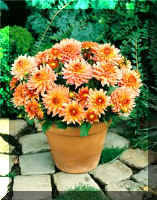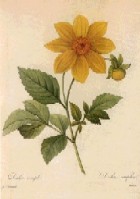
|
Dahlia Culture Classification Single, Semidouble Double-Flowered Culture and care |
Dahlia
Culture Dahlias are easy to grow. They are grown on a lot of different places in many countries of all the continents. And they are grown in all kinds of soil. On these pages we want to offer helpfull information to help them grow even better. To start with we will tell some about the origin of the dahlia, the history of cultivation, the classification of all those different types of dahlias and the general growing guidelines. |
||
 |
DAHLIA..... Everyone loves them,... anyone can grow them! The dahlia is one of the prettiest and most versatile of ornamental plants. In the extensive colour range offered by dahlias, the only colours missing are true black and blue. They often display two colours as well. And besides their many bright colours, dahlias are also appreciated for the many shapes they can have. |
||
|
|||
|
|||
| In 1810, the cultivation of dahlias started to develop in
the Netherlands. In 1813, a grower by the name of C. Arentz in
Leiden had bred one of the first entirely double flowers. Arentz
was truly one of the pioneering dahlia growers in the
Netherlands: in 1819, he was already offering an assortment
containing about 70 varieties (colours). Since that time, many
people who became fascinated with this plant have succeeded in
crossing many, many cultivars in all kinds of variations. It is
estimated that 20,000 different kinds have been developed, but
this number could be much higher if we count the ones developed
all over the world. Then, about 100 years later, the Netherlands Dahlia Society was founded in 1918. Its most important goal was (and still is) to encourage the cultivation of, the trade in, and the export of dahlias. The association consists of both amateurs and professional growers and devotes a major part of its energies to promotional activities in the Netherlands and abroad in the form of organising and participating in indoor and outdoor expositions, as well as the holding of field and flower inspections and establishing the regulations for these inspections. By that time, the cultivation of dahlias had become so widespread and popular that guidelines and regulations were necessary. To make the many different types of dahlias more accessible to the public, the assortment was classified into a certain number of groups. New cultivars were then registered according to this classification as set up by the guidelines of the Royal Horticultural Society, an organisation that is internationally accepted as the authority for the registration of many ornamental plants, including the dahlia. Within the Netherlands, the registrations are conducted by the Nomenclature Department of the Royal Dutch Bulb Growers' Association (KAVB). The varieties are planted at this association's Testing and Specimen Garden, so that the various characteristics of the variety can be assessed during a growing season. |
|||

